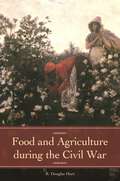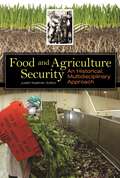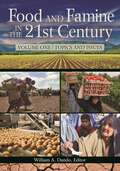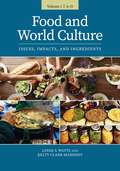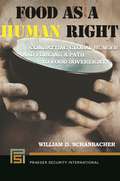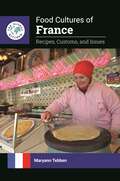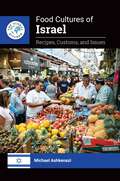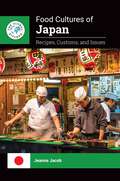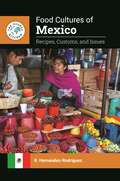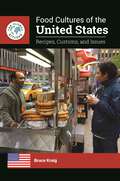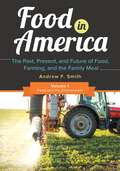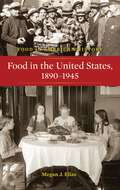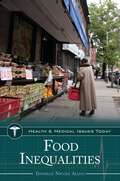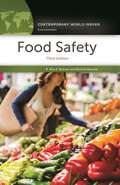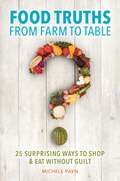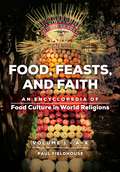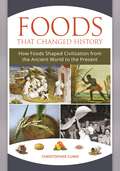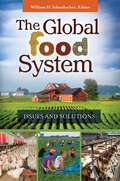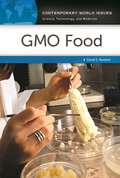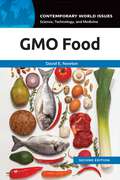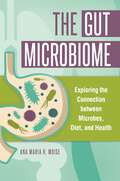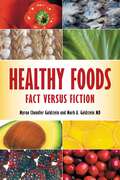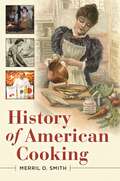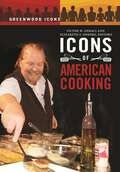- Table View
- List View
Food and Agriculture during the Civil War (Reflections on the Civil War Era)
by R. Douglas HurtThis book provides a perspective into the past that few students and historians of the Civil War have considered: agriculture during the Civil War as a key element of power.The Civil War revolutionized the agricultural labor system in the South, and it had dramatic effects on farm labor in the North relating to technology. Agriculture also was an element of power for both sides during the Civil War—one that is often overlooked in traditional studies of the conflict. R. Douglas Hurt argues that Southerners viewed the agricultural productivity of their region as an element of power that would enable them to win the war, while Northern farmers considered their productivity not only an economic benefit to the Union and enhancement of their personal fortunes but also an advantage that would help bring the South back into the Union.This study examines the effects of the Civil War on agriculture for both the Union and the Confederacy from 1860 to 1865, emphasizing how agriculture directly related to the war effort in each region—for example, the efforts made to produce more food for military and civilian populations; attempts to limit cotton production; cotton as a diplomatic tool; the work of women in the fields; slavery as a key agricultural resource; livestock production; experiments to produce cotton, tobacco, and sugar in the North; and the adoption of new implements.
Food and Agriculture Security: An Historical, Multidisciplinary Approach (Praeger Security International)
by Justin KastnerThis work is a historical, multidisciplinary explanation of the complexities of the food system in the United States and around the world, spanning the beginning of the modern era to today's globalized, interconnected market.A revolution in food supply and trade has been ongoing for decades, although most American consumers have been unaware of these changes—after all, to the end buyer, the food seems the same at the supermarket. But today, a large percentage of our food and agricultural products are imported to our country, and the U.S. Department of Homeland Security has designated Food and Agriculture as a "Critical Infrastructure and Key Resources Sector." Cross-border cooperation is essential, given the volume of trade, the nature of testing required, and the importance of ensuring the safety of these products.This book examines our food system in its entirety, discusses threats to food and agriculture security in America and abroad, and covers trade policy issues and U.S.-specific regulations affecting the food supply chain security. Emerging models of cross-border cooperation in Food and Agriculture Security are also described.
Food and Famine in the 21st Century [2 volumes]: [2 volumes]
by Andrew D. Lohman Andrew Walter Ann Myatt James Bharath Ganesh-Babu Bimal Kanti Paul Carl Haub Christina E. Dando Christine Drake Danny M. Vaughn Dawn M. Drake Deborah Greenwood Dennis Skelton Donald J. Zeigler Frederick L. Bein Gregory Gaston John J. Hidore Joyce V. Cadwallader Kacey Mayes Kathleen Lamb Kozenski Kausar F. Siddiqi Kay Weller Melissa Martin Michael W. Kerwin Paul M. Chandler Paul Mausel Richard Snow Robin Leichenko Samuel T. Ledermann Sara A. Blackburn Stephen Aldrich Stephen J. Stadler Vijay Lulla Wiley C. Thompson William A. DandoThis comprehensive two-volume encyclopedia examines specific famines throughout history and contains entries on key topics related to food production, security and policies, and famine, giving readers an in-depth look at food crises and their causes, responses to them, and outcomes.Famines have claimed more lives across human history than all the wars ever fought.This two-volume set represents the most comprehensive study of food and famine currently available, providing the broadest analysis of hunger and famine causes as well as a detailed examination of the ramifications of cultural and natural hazards upon famine.Volume one focuses upon 50 topics and issues relating to the creation of hunger and famines in the world from 4000 BCE to 2100, including an overview of how agriculture has evolved from primitive hunting and gathering that supported limited numbers of people to a worldwide system that now feeds over seven billion people. Volume two, entitled Classic Famines, begins with famines of the past, from 4000 BCE to 2100 CE, includes ten classic famine case studies, and concludes with predictions of famines we could see in the 21st century and beyond.
Food and World Culture [2 volumes]: Issues, Impacts, and Ingredients [2 volumes]
by Linda S. Watts Kelty Clark-MahoneyThis book uses food as a lens through which to explore important matters of society and culture. In exploring why and how people eat around the globe, the text focuses on issues of health, conflict, struggle, contest, inequality, and power.Whether because of its necessity, pleasure, or ubiquity, the world of food (and its lore) proves endlessly fascinating to most people. The story of food is a narrative filled with both human striving and human suffering. However, many of today's diners are only dimly aware of the human price exacted for that comforting distance from the lived-world realities of food justice struggles. With attention to food issues ranging from local farming practices to global supply chains, this book examines how food&’s history and geography remain inextricably linked to sociopolitical experiences of trauma connected with globalization, such as colonization, conquest, enslavement, and oppression.The main text is structured alphabetically around a set of 70 ingredients, from almonds to yeast. Each ingredient's story is accompanied by recipes. Along with the food profiles, the encyclopedia features sidebars. These are short discussions of topics of interest related to food, including automats, diners, victory gardens, and food at world&’s fairs. This project also brings a social justice perspective to its content—weighing debates concerning food access, equity, insecurity, and politics.
Food as a Human Right: Combatting Global Hunger and Forging a Path to Food Sovereignty (Praeger Security International)
by William D. SchanbacherThis important work addresses the difficult ethical issues surrounding the accessibility of food to all people as a human right, and not a privilege that emerges because of social structure or benefit of geography.Food sovereignty—the right of peoples to define their own chosen food and agriculture, free of monopolization or threats—is the path to stopping global hunger. This book approaches the topic from a solutions-based perspective, discussing concrete policy providing for sovereignty, or control, of one's own food sources as a solution that, while controversial, offers more promise than do the actions of international organizations and trade agreements. Providing access to safe, healthy food is an ethical responsibility of the world's nations, not just a right of the elite or wealthy.This book presses the need to formulate policies that address the problems of poverty and hunger on a more humane and meaningful level. Organized thematically, chapters are based on such topics as food security, food sovereignty, human rights, and sustainability that focus on the global food system. Specific case studies provide examples of global hunger and poverty issues. Taken in its entirety, the book informs readers of how their food consumption might negatively affect the global poor, while its concluding chapters offer solutions for alleviating problems in the global food system.
Food Cultures of France: Recipes, Customs, and Issues (The Global Kitchen)
by Maryann TebbenAs a comprehensive overview of French food from fine dining to street food and from Roman Gaul to current trends, this book offers anyone with an interest in French cuisine a readable guide to the country and its customs.In France, food is integral to the culture. From the Revolutionary cry for good bread at a fair price to the current embrace of American bagels and "French tacos," this book tells the full story of French food.Food Cultures of France: Recipes, Customs, and Issues explores the highs and lows of French cuisine, with examples taken from every historical era and all corners of France. Readers can discover crêpes from Brittany; fish dumplings from Lyon; the gastronomic heights of Parisian restaurant cuisine; glimpses of the cuisines of France's overseas territories in Africa and the Caribbean; and the impact of immigrant communities on the future of French food. Learn how the geography of France shaped the diet of its people and which dishes have withstood the test of time. Whether the reader knows all about French cuisine or has never tasted a croissant, this book will offer new insights and delicious details about French food in all its forms.
Food Cultures of Israel: Recipes, Customs, and Issues (The Global Kitchen)
by Michael AshkenaziThis volume explores cuisine in Israel, including the country's food culture history, important dishes, current food issues, and more.The evolution of Israeli food has been dependent on three major variables: the geography and climate of Israel, its ethnic mix and ethnic history (including religious influences, non-Jewish communities, and heavy immigration from around the world), and technical innovation that has enabled Israel to become a leader in agricultural technology.This book provides a comprehensive picture of Israeli food culture in the twenty-first century, examined on the basis of the various influences that created this particular culture. Such influences include the lengthy food history that can be traced to prehistory, including data from the Bible and Koran and archaeological evidence; as well as contemporary food practices that have emerged as a mix of influences from different ethnic groups. Modern Israeli food practices are the result of the sway of European, Middle Eastern, and other cultures, creating a cuisine that is marked by its blends. Main topics are accompanied by easy-to-follow recipes. The book serves as an introduction to daily life in Israel as well as the evolution of food practices in a relatively new country.
Food Cultures of Japan: Recipes, Customs, and Issues (The Global Kitchen)
by Jeanne JacobThis addition to the Global Kitchen series explores the cuisine of Japan, from culinary history and important ingredients to essential daily and special meals.When we think of Japanese food in the United States, certain images come to mind: sushi, ramen, and hibachi restaurants. But what is food like in this island nation? What do people eat and drink every day? Are food concerns similar to those in the United States, where obesity is a major issue?This volume offers comprehensive coverage on the cuisine of Japan. Readers will learn about the history of food in the country, influential ingredients that play an important role in daily cooking and consumption, meals and dishes for every occasion, and what food is like when dining out or stopping for snacks from street vendors. An additional chapter examines food issues and dietary concerns. Recipes accompany every chapter. A chronology, glossary, sidebars, and bibliography round out the work.
Food Cultures of Mexico: Recipes, Customs, and Issues (The Global Kitchen)
by R. Hernandez-RodriguezThis exciting volume brings to life the food culture of Mexico, detailing the development of the cuisine and providing practical information about ingredients and cooking techniques so that readers can replicate some of Mexico's most important traditional dishes.Mexican food has become one of the most popular cuisines in the United States, with noted dishes ranging from tacos and enchiladas to tamales and guacamole. What are the origins of Mexican food culture as we know it today?Written with an educated—not specialized—audience in mind, the book includes descriptions of traditional and high cuisine, regional and national foods, everyday dishes and those prepared and served on holidays and special occasions. It also discusses ancestral eating habits and the way the food has been transformed under the pressures of globalization.Specific chapters examine food history, important ingredients, typical appetizers, main meals, desserts, street foods and snacks, dining out, and food issues and dietary concerns. Recipes accompany every chapter. Rounding out the work are a chronology of food history, a glossary, sidebars, and a bibliography. This volume is ideal for any students learning about Mexican food and culture, as well as general readers who would like to learn more about international cuisines.
Food Cultures of the United States: Recipes, Customs, and Issues (The Global Kitchen)
by Bruce KraigThis comprehensive volume examines the history of American food culture and cuisine today, from staple ingredients to dietary concerns.Everyday, without realizing it, Americans plan their days around food—what to make for dinner, where to meet for brunch, what to bring to a party. As a nation of immigrants, the U.S. has food and foodways that few countries in the world have. This addition to the Global Kitchen series examines all aspects of food culture in the United States, from the early Colonial period and Native American influences on the new immigrants' food to the modern era.The volume opens with a Chronology that looks at United States history and significant food events. Coverage then dives deep into the history of food in the U.S., and is followed by a chapter on influential ingredients in American cooking. Chapters break down American cuisine into appetizers and side dishes, main dishes, and desserts, looking at typical meals and flavors that characterize it. Additional chapters examine food eaten during holidays and on special occasions, street food and snacks, and restauarants. A final chapter looks at issues and dietary concerns. Recipes round out each chapter.
Food in America [3 volumes]: The Past, Present, and Future of Food, Farming, and the Family Meal [3 volumes]
by Andrew F. SmithThis three-volume work examines all facets of the modern U.S. food system, including the nation's most important food and agriculture laws, the political forces that shape modern food policy, and the food production trends that are directly impacting the lives of every American family.Americans are constantly besieged by conflicting messages about food, the environment, and health and nutrition. Are foods with genetically modified ingredients safe? Should we choose locally grown food? Is organic food better than conventional food? Are concentrated animal feed operations destroying the environment? Should food corporations target young children with their advertising and promotional campaigns? This comprehensive three-volume set addresses all of these questions and many more, probing the problems created by the industrial food system, examining conflicting opinions on these complex food controversies, and highlighting the importance of food in our lives and the decisions we make each time we eat.The coverage of each of the many controversial food issues in the set offers perspectives from different sides to encourage readers to examine various viewpoints and make up their own minds. The first volume, Food and the Environment, addresses timely issues such as climate change, food waste, pesticides, and sustainable foods. Volume two, entitled Food and Health and Nutrition, addresses subjects like antibiotics, food labeling, and the effects of salt and sugar on our health. The third volume, Food and the Economy, tackles topics such as food advertising and marketing, food corporations, genetically modified foods, globalization, and megagrocery chains. Each volume contains several dozen primary documents that include firsthand accounts written by promoters and advertisers, journalists, politicians and government officials, and supporters and critics of various views related to food and beverages, representing speeches, advertisements, articles, books, portions of major laws, and government documents, to name a few. These documents provide readers additional resources from which to form informed opinions on food issues.
Food in the United States, 1890-1945 (Food in American History)
by Megan J. EliasNo American history or food collection is complete without this lively insight into the radical changes in daily life from the Gilded Age to World War II, as reflected in foodways.From the Gilded Age to the end of World War II, what, where, when, and how Americans ate all changed radically. Migration to urban areas took people away from their personal connection to food sources. Immigration, primarily from Europe, and political influence of the Caribbean, Latin America, and the Pacific brought us new ingredients, cuisines, and foodways. Technological breakthroughs engendered the widespread availability of refrigeration, as well as faster cooking times. The invention of the automobile augured the introduction of "road food," and the growth of commercial transportation meant that a wider assortment of foods was available year round. Major food crises occurred during the Depression and two world wars. Food in the United States, 1890-1945 documents these changes, taking students and general readers through the period to explain what our foodways say about our society. This intriguing narrative is enlivened with numerous period anecdotes that bring America history alive through food history.
Food Inequalities (Health and Medical Issues Today)
by Tennille Nicole AllenThis book provides an accessible introduction to food inequality in the United States, offering readers a broad survey of the most important topics and issues and exploring how economics, culture, and public policy have shaped our current food landscape.Food inequality in the United States can take many forms. From the low-income family unable to afford enough to eat and the migrant farm worker paid below minimum wage to city dwellers stranded in an urban food desert, disparities in how we access and relate to food can have significant physical, psychological, and cultural consequences. These inequalities often have deep historical roots and a complex connection to race, socioeconomic status, gender, and geography.Part of Greenwood's Health and Medical Issues Today series, Food Inequalities is divided into three sections. Part I explores different types of food inequality and highlights current efforts to improve food access and equity in the U.S. Part II delves deep into a variety of issues and controversies related to the subject, offering thorough and balanced coverage of these hot-button topics. Part III provides a variety of useful supplemental materials, including case studies, a timeline of critical events, and a directory of resources.
Food Labels: Your Questions Answered (Q&A Health Guides)
by Barbara A. BrehmThis book provides an approachable introduction to food labels. While aimed primarily at teens and young adults, it is a valuable tool for anyone who wants to better understand what food labels are really saying and make healthy food choices.How accurate is the Nutrition Facts Panel, and who decides what information goes on it? Why don't all foods have nutrition or ingredient information? How can you tell if a product is organic, non-GMO, or ethically produced? Are words such as "all-natural" and "light" on packaging meaningful or just clever marketing? Food Labels: Your Questions Answered, a part of Greenwood's Q&A Health Guides series, provides clear, concise answers to these and many other questions readers may have about the labels and health claims found on food packaging.Each book in this series follows a reader-friendly question-and-answer format that anticipates readers' needs and concerns. Prevalent myths and misconceptions are identified and dispelled, and a collection of case studies illustrates key concepts and issues through relatable stories and insightful recommendations. The book also includes a section on health literacy, equipping teens and young adults with practical tools and strategies for finding, evaluating, and using credible sources of health information both on and off the internet—important skills that contribute to a lifetime of healthy decision-making.
Food Safety: A Reference Handbook (Contemporary World Issues)
by Nina E. Redman Michele MorronePresenting compelling and current information about some of the most important food safety issues, this book is an invaluable reference for anyone interested in avoiding foodborne disease or understanding how food safety standards could be improved.Food safety affects everyone. For citizens who live in industrialized nations, it is easy to assume that our foods are always rigorously inspected and assessed for safety. While food safety standards and regulations are in place to protect the consumer public, food safety problems do exist: according to the Centers for Disease Control and Prevention, each year, 48 million Americans are sickened by food,128,000 people are sick enough that they are hospitalized as a result, and 3,000 people die from foodborne pathogens.This third edition of Food Safety: A Reference Handbook examines the history of food safety and describes in detail key events and trends that have created the food safety issues of today. It explores the many controversies concerning food consumption, including contaminants in food, GMOs, factory farm-produced meat, and standards regarding the labeling of food products as well as the ways that these issues have been handled by authorities. Readers will find this book's overview of food safety topics informative and highly accessible. Additionally, the perspectives chapter provides varying viewpoints from food safety professionals and researchers on key issues.
Food Truths from Farm to Table: 25 Surprising Ways to Shop & Eat without Guilt
by Michele PaynDon't believe everything you're told about food—most of it is highly misleading or completely untrue. Written by a farm and food advocate, this book identifies marketing half-truths and guides you through the aisles of the grocery store to simplify smart food shopping and restore your freedom to enjoy food.What is the only "food" on your dinner table that does not contain hormones? How can animals raised for food also be treated with respect? Is it true that a typical serving of broccoli has more estrogen than a serving of steak? Why is more than 40 percent of food wasted in the United States? Food Truths from Farm to Table: 25 Surprising Ways to Shop & Eat without Guilt answers all of these questions and many more, bringing an unheard voice into the highly emotional food debate. Authored by Michele Payn, a leading farm and food advocate with an in-depth understanding of both sides of the plate, this intriguing book helps readers understand how food is really produced, answers food critics, and points out how food marketing and labels are often half-truths or even "less-than-half truths." These 25 food truths enable an understanding of how food is grown, providing a transparent window into today's farming and ranching practices that empowers you to make informed personal choices and determine what is right for your family. Each chapter presents a farm or ranch story, answers questions around a major issue, provides science-based information, and includes a sidebar section of food truths and myths.Readers will gain insights from a food expert who offers a viewpoint that stands in stark contrast to the typical sensationalist and often negative perspective on fashionable food—accurate information that will help you to better trust the intentions and processes in farming and ranching. The revelations in this book will simplify food shopping, reduce guilt about being a consumer, and give you the freedom to enjoy your food again.
Food, Feasts, and Faith [2 volumes]: An Encyclopedia of Food Culture in World Religions [2 volumes]
by Paul FieldhouseAn indispensable resource for exploring food and faith, this two-volume set offers information on food-related religious beliefs, customs, and practices from around the world.Why do Catholics eat fish on Fridays? Why are there retirement homes for aged cows in India? What culture holds ceremonies to welcome the first salmon? More than five billion people worldwide claim a religious identity that shapes the way they think about themselves, how they act, and what they eat. Food, Feasts, and Faith: An Encyclopedia of Food Culture in World Religions explores how the food we eat every day often serves purposes other than to keep us healthy and stay alive: we eat to express our faith and to adhere to ethnic or cultural traditions that are part of who we are. This book provides readers with an understanding of the rich world of food and faith. It contains more than 200 alphabetically arranged entries that describe the beliefs and customs of well-established major world religions and sects as well as those of smaller faith communities and new religious movements. The entries cover topics such as religious food rules, religious festivals and symbolic foods, and vegetarianism and veganism, as well as general themes such as rites of passage, social justice, hospitality, and compassion.Each entry on religion explains what the religious dietary laws and guidelines are and how these were interpreted and put into practice historically and in modern settings. The coverage also includes important festivals and feast days as well as significant religious figures and organizations. Additionally, some 160 sidebars provide examples and more detailed information as well as fun facts.
Foods That Changed History: How Foods Shaped Civilization from the Ancient World to the Present
by Christopher CumoServing students and general readers alike, this encyclopedia addresses the myriad and profound ways foods have shaped the world we inhabit, from prehistory to the present.Written with the needs of students in mind, Foods That Changed History: How Foods Shaped Civilization from the Ancient World to the Present presents nearly 100 entries on foods that have shaped history—fascinating topics that are rarely addressed in detail in traditional history texts. In learning about foods and their importance, readers will gain valuable insight into other areas such as religious movements, literature, economics, technology, and the human condition itself.Readers will learn how the potato, for example, changed lives in drastic ways in northern Europe, particularly Ireland; and how the potato famine led to the foundation of the science of plant pathology, which now affects how scientists and governments consider the dangers of genetic uniformity. The entries document how the consumption of tea and spices fostered global exploration, and how citrus fruits led to the prevention of scurvy. This book helps students acquire fundamental information about the role of foods in shaping world history, and it promotes critical thinking about that topic.
The Global Food System: Issues and Solutions
by William D. Schanbacher, EditorThis detailed analysis of the global food system looks at the way food is produced, distributed, and consumed in an effort to create a more equitable and healthful system worldwide.With large-scale famine afflicting regions around the globe and overconsumption and unhealthy eating habits destroying others, many are beginning to wonder if access to food is less of a class-based social problem and more of an ethical issue affecting the lives—and livelihoods—of people all over the world. This thoughtful text provides a thorough examination of the factors contributing to this global concern, exploring the complexities of international food supply and demand as well as the efforts to bring about a more just global food system.Through this groundbreaking volume, author and educator Will Schanbacher sheds light on flaws in the current structure and suggests ways to achieve a more balanced approach. He considers the economics, politics, and activism behind and involved in the production, distribution, and consumption of the global food system. In an effort to illuminate many problems associated with hunger, inequality, and injustice in the food system, the book also offers many potential strategies and solutions for making a more healthy, sustainable, and equitable world. Chapters contain both theoretical models and concrete practices for food security and offer strategies for creating an equitable system.
GMO Food: A Reference Handbook (Contemporary World Issues)
by David E. NewtonProviding an exhaustive background on the history of genetically modified organism (GMO) crops and foods as well as the controversies surrounding these products, this book allows readers to develop their own particular viewpoint on the production and use of GMO substances.Genetic engineering has long been used to impart desirable characteristics to food plants in order to improve crop yield, pest resistance, and herbicide tolerance. Genetic modification of foods, however, has created a storm of controversy everywhere in the world—including the United States. What are the benefits of and risks involved with genetically modified organisms (GMO) and crops? What powerful industry pressures have extended the sale and use of GMO foods and crops globally? And how should consumer food products that involve GM ingredients be labeled? GMO Food: A Reference Handbook addresses these questions and the complex issues involved, allowing readers to fully understand why genetically modified organisms represent one of the most important issues in the 21st century.The book provides clear, factual information and background on the history of genetically modified crops and foods, covering topics such as the historic methods of plant and animal modification (such as cross-breeding) and important discoveries in genetics, biochemistry, molecular biology, genetic engineering, and related fields; the social, political, philosophical, and economic issues that have arisen with these scientific advances; and the laws and regulations that have resulted from the range of attitudes about GMO foods. The book also supplies additional resources for readers performing extensive research in an annotated bibliography of books, articles, reports, and web pages.
GMO Food: A Reference Handbook (Contemporary World Issues)
by David E. NewtonGMO Food: A Reference Handbook offers an in-depth discussion of genetically modified food. It covers the history of, opposition to, regulation of, and labeling of genetic modifications, along with the potential benefits and harm involved.GMO Food: A Reference Handbook is intended to serve as a research guide for young adults in high school and beyond. Students at all grade levels should be able to use the book as an introduction to the history of genetic engineering of organisms and the use of this technology for the development of new forms of crops and foods.They will learn briefly about historic methods of plant and animal modification (such as cross-breeding) and, in more detail, how discoveries since the late nineteenth century have greatly changed the process of plant and animal modification. These discoveries include important steps forward in genetics, biochemistry, molecular biology, genetic engineering, and related fields. They will also learn about the variety of social, political, philosophical, economic, and other issues that have arisen alongside these scientific advances, as well as about some of the laws, regulations, and other solutions that have been developed for dealing with the range of attitudes about genetically modified foods. The second edition covers developments since 2014.
The Gut Microbiome: Exploring the Connection between Microbes, Diet, and Health
by Ana Maria MoiseThis accessibly written, comprehensive summary of research findings on the gut microbiome and its implications for health and disease—a topic of growing interest and concern—serves as an essential resource for teachers and students.Most people know that the digestive tract contains billions of helpful gut bacteria, but how does the gut microbiome affect our health? What exactly do these bacteria do, and what are the negative effects when these microorganisms are harmed by what we eat and do? What impacts might they have on conditions such as irritable bowel syndrome (IBS), obesity, and autism? This book provides an accessible, holistic introduction to the study of the human gut microbiome and its effects on digestion and disease—one of the newest and most rapidly expanding fields in medicine today.The gut microbiome is known as "the forgotten organ" because it is not identified as part of the human body per se, yet it has an immense influence on many systems in the body. The Gut Microbiome: Exploring the Connection between Microbes, Diet, and Health explains what the microbiome is, the many functions it serves, how it can be either harmed or supported by our actions, and the role it may play in various diseases and in determining our overall health. The book examines the various potential causes of imbalance in the microbiome, such as diet and other lifestyle factors, and then identifies strategies for improving human health by protecting the gut microbiota. The science-based information is detailed but accessible to general readers or students without extensive background knowledge.
Healthy Foods: Fact versus Fiction
by Myrna Chandler Goldstein Mark A. MDThis book presents research findings about 50 foods that are commonly touted as healthy and educates readers about the medical problems they purportedly alleviate or help prevent.It is always in the best interest of those who market foods to make grandiose claims regarding their nutritional value, regardless of whether actual scientific proof exists to support such a claim. Even diligent and educated consumers often have difficulty discerning facts from mere theory or pure marketing hype.As the incidence of childhood obesity in the United States continues to increase at an alarming rate and food costs skyrocket, this book arrives at a perfect time for health-conscious consumers, providing an authoritative reference for anyone looking to make wise eating decisions at home, work, school, or in restaurants. Healthy Foods: Fact versus Fiction is the result of a collaborative effort between a medical doctor and an award-winning journalist and author on nutrition. This book provides actual research findings to shed light on the true benefits of the most popular health foods—and in some cases, debunk misconceptions surrounding certain foods.
History of American Cooking
by Merril D. SmithIdeal for American history and food history students as well as general readers, this book spans 500 years of cooking in what is now the United States, supplying recipes and covering the "how" and "why" of eating.This book examines the history and practice of cooking in what is now the United States from approximately the 15th century to the present day, covering everything from the hot-stone cooking techniques of the Nootka people of the Pacific Northwest to the influence of Crisco—a shortening product intended as a substitute for lard—upon American cooking in the 20th century. Learning how American cooking has evolved throughout the centuries provides valuable insights into life in the past and offers hints to our future.The author describes cooking methods used throughout American history, spotlighting why particular methods were used and how they were used to produce particular dishes. The historical presentation of information will be particularly useful to high school students studying U.S. history and learning about how wartime and new technology affects life across society. General readers will enjoy learning about the topics mentioned above, as well as the in-depth discussions of such dishes as fried chicken, donuts, and Thanksgiving turkey. Numerous sample recipes are also included.
Icons of American Cooking (Greenwood Icons)
by Victor W. Geraci Elizabeth S. Demers, EditorsDiscover how these contemporary food icons changed the way Americans eat through the fascinating biographical profiles in this book.Before 1946 and the advent of the first television cooking show, James Beard's I Love to Eat, not many Americans were familiar with the finer aspects of French cuisine. Today, food in the United States has experienced multiple revolutions, having received—and embraced—influences from not only Europe, but cultures ranging from the Far East to Latin America. This expansion of America's appreciation for food is largely the result of a number of well-known food enthusiasts who forever changed how we eat. Icons of American Cooking examines the giants of American food, cooking, and cuisine through 24 biographical profiles of contemporary figures, covering all regions, cooking styles, and ethnic origins. This book fills a gap by providing behind-the-scenes insights into the biggest names in American food, past and present.
